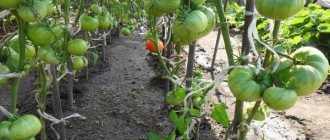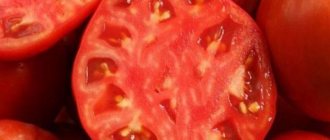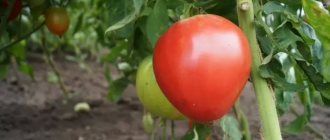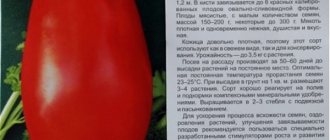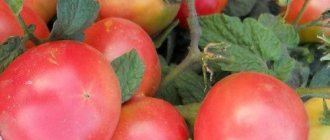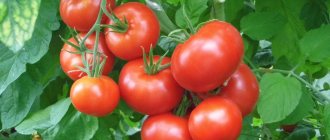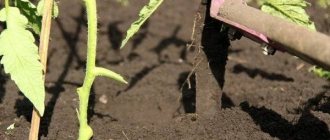Description and characteristics of the variety
The fruits of this hybrid are fleshy, juicy and so tasty that tasting can surprise even a sophisticated gourmet. To get a high yield and excellent results, you need to know the rules of care and cultivation, become familiar with the distinctive features and characteristics of this tomato. F1 pink cheeks are medium early. The time from sowing seeds to ripening of fruits is 110–120 days. The plant is of a determinant type (growth limitation due to the formation of flowers at the top), that is, low-growing.
Growing such tomatoes is convenient, since pruning of the bushes is almost not required. The growth of the bush is 70–80 cm, in closed ground conditions it can reach 1.5 m with an artificial increase in the height of the bush, which allows increasing productivity. Despite its limitations, it grows well and can reach a large volume. The leaves are medium sized, light green.
The inflorescence is a simple raceme; 3–5 large, flat-round tomatoes grow on it, which, when ripe, acquire a bright raspberry-pink color. Unripe tomatoes are green in color with a dark spot around the stalk. Tomato weight is 200–350 g. The hybrid is recommended for cultivation in greenhouses, as well as in open areas of land.
Did you know? The tomato was known in the mountainous regions of Peru and Mexico as an edible plant back in the 5th century BC, and came to Europe only in the 16th century and was used as an exotic ornamental planting.
F1 rosy cheeks have the following characteristics:
- the pulp of the fruit is dense, fleshy and juicy;
- tomatoes are mostly the same size and size, large;
- peel of medium density and thickness;
- number of seed chambers - at least 4;
- the first inflorescence is above the 6–8 leaf;
- The shape of the fruit is standard - flat-round with mild ribbing;
- high taste qualities;
- versatility of use (used raw, for pickling, canning, making tomato puree and juice).
The hybrid was developed by seed breeding specialists in 2002 (Russia, Moscow region, Mytishchi). Registered in the State Register of the Russian Federation in 2003, recommended for cultivation in closed ground (allowed in open areas in the southern regions).
Fruit characteristics
- Tomatoes have a traditional flat, round shape with mild ribbing.
- Once a tomato reaches maturity, the color of the fruit begins to change from dark green to bright pink, and sometimes even crimson.
- Tomatoes have dense, but at the same time fleshy, juicy pulp, medium-thick skin, and the number of seed chambers should not be less than four.
- A distinctive feature is that the fruits are equal in size, they are quite large, the average weight of one is about 300 g.
- The “pink cheeks” tomato is distinguished by high taste characteristics, however, it should be noted that growing in unfavorable conditions can affect both the appearance of the tomatoes and their taste.
- The purpose of this variety is universal: they are salted, used in salads, and made into excellent tomato juice and paste. For pickling, it is best to use various containers in the form of pans, barrels, buckets, since due to their large size the fruits do not fit in a jar.
Among the features of tomatoes, it can be noted that, despite their large size, they are easily transported and stored well. For this reason, they can be recommended for cultivation by farmers.
When cooking with tomatoes, it is recommended to remove the skins and seeds. They do not have beneficial properties; on the contrary, they are poorly absorbed by the body, which must be taken into account when preparing food for children and older people. During heat treatment, the skin separates, curls and gives the food an unsightly appearance, nullifying all the efforts of the cook.
Did you know? Cooking tomatoes increases the amount of lycopene (an antioxidant that prevents the growth of cancer cells), which is why tomato juice, paste and sauces are considered healthier than fresh tomatoes.
Before eating, be sure to wash the tomatoes and remove the stem. When preparing the sauce, the tomato is fried for 10–15 minutes, grilled for 3–4 minutes. For quick frying, cut the tomatoes into circles and fry in oil for 2-3 minutes. When eating fresh tomatoes, it is recommended to add vegetable oil, cream, mayonnaise, sour cream to them - they are more easily absorbed by the body, and a large amount of vitamins are retained.
Small tomatoes are suitable for stuffing, larger ones - for preparing fresh salads, sauces, soups, stews, fresh and canned tomato juice.
The vegetable is used to make tomato paste, ketchup and salads with other vegetables. Tomatoes are well absorbed by the human body along with cucumbers, onions, cabbage, lettuce, herbs, and carrots.
For preservation, medium-sized vegetables are selected, without flaws, of the same ripeness. The fruits must pass freely through the neck of the jar without being subject to mechanical damage. Marinated, salted, sun-dried tomatoes, salads, pasta, sauces, lecho, juices - this abundance of tomato products can delight you all year round.
Adhering to the recommendations of the seed manufacturer, following the rules of agricultural technology, care and proper care of plants is the key to a good harvest of piquant, aromatic and tasty tomatoes Rosy cheeks F1 in your garden bed.
Tomatoes are incredibly tasty fresh. However, the versatility of use allows the fruits to be used for preservation and for the production of tomato paste. Suitable containers for pickling are buckets, barrels or pans, since large fruits will not fit in jars.
Gardeners who cultivate the Rosy Cheeks variety claim that they get the most out of tomatoes under film covers and in the open ground of the southern regions.
Evgenia Samoilova, 51 years old, Kemerovo.
Last season I purchased a packet of Pink Cheeks seeds from a well-known brand. Grown by seedling method. The formed seedlings were planted in a greenhouse. During the growing period, the bushes reached 130 cm in height. I really liked the beautiful pink tomatoes. All were even, the same size, it was even a pity to use them for canning.
Advantages and disadvantages of the variety
Tomatoes Rosy cheeks, having many positive reviews from gardeners, justify their favor with their characteristic advantages.
- The advantages of tomato include:
- excellent taste (balanced amount of acid and sugar, gives tomatoes a special taste and delicate aroma);
- good transportability (retains excellent presentation during transportation);
- preserves well for a long time;
- versatility of cultivation (in open ground, in greenhouses);
- high resistance to diseases (before late blight appears on the fruits, it usually manages to produce a good harvest);
- large fruits (weight 200–350 g);
- absence of cracking (when weather conditions change, precipitation preserves the integrity of the fruit);
- good yield (5–6 kg per 1 m²).
According to reviews from vegetable growers, this variety has no disadvantages. To obtain the expected high yield, in their opinion, it should be grown in greenhouses, but also in open ground, with the right approach, you can get a stable harvest. The tomato also grows in open areas, characterized by good productivity and unpretentiousness to growing conditions. Of course, there are certain growing conditions under which the result is achieved.
Tomato “Thick Cheeks”: description of the variety
| Variety name | Thick cheeks |
| general description | Mid-season determinate variety |
| Originator | Russia |
| Ripening period | 110-116 days |
| Form | Flat-rounded |
| Color | Red |
| Average weight of tomatoes | 160-210 grams |
| Application | Universal |
| Productivity of the variety | 4.5-5 kg per bush |
| Features of cultivation | Standard agricultural technology |
| Disease resistance | Resistant to many diseases |
Determinate, rather unpretentious variety of tomatoes. Recommended for growing in greenhouses, tunnel shelters and open beds. A variety with an average ripening period, 110-116 days pass from planting seeds for seedlings to harvesting fruits. Gardeners who grew this variety recommend removing some of the leaves to improve the illumination of the bushes.
The bush is powerful, 55-60 high, when grown in greenhouses up to 70 centimeters. A large number of leaves, the usual shape and color of a tomato. The best results are shown when formed into two stems. Due to the considerable weight of tomatoes on the bush, tying the bush to a support is required.
Description of fruits:
- The fruits have a well-defined red color.
- Flat-round shape.
- Weighing 160-210 grams.
- They have a good, slightly sweet taste.
- Excellent presentation.
- Shows high safety during transportation.
You can compare the weight of the fruits of this variety with other varieties in the table:
| Variety name | Fruit weight |
| Thick cheeks | 160-210 grams |
| Big Mama | 200-400 grams |
| Banana legs | 60-110 grams |
| Petrusha the gardener | 180-200 grams |
| Honey saved | 200-600 grams |
| Beauty King | 280-320 grams |
| Pudovik | 700-800 grams |
| Persimmon | 350-400 grams |
| Nikola | 80-200 grams |
| Right size | 300-800 |
All catalogs indicate the salad purpose of the fruit, but the reviews received say that tomatoes salted for the winter do not crack. Great for making salads, pastes, purees, juices.
Advantages of the variety:
- Compactness of the bush.
- High yield.
- Good commercial quality.
- Resistance to verticillium and fusarium.
- Not bad preservation.
According to numerous reviews received from gardeners, no significant shortcomings were identified.
You can compare the yield of this variety with others in the table:
| Variety name | Productivity |
| Thick cheeks | 4.5-5 kg per bush |
| Aurora f1 | 13-16 kg per square meter |
| Domes of Siberia | 15-17 kg per square meter |
| Sanka | 15 kg per square meter |
| Red cheeks | 9 kg per square meter |
| Kibitz | 3.5 kg per bush |
| Heavyweight of Siberia | 11-12 kg per square meter |
| Pink fleshy | 5-6 kg per square meter |
| Ob domes | 4-6 kg per bush |
| Red icicle | 22-24 kg per square meter |
Read on our website how to properly grow large tomatoes, along with cucumbers, along with peppers, and how to grow good seedlings for this.
And also methods for growing tomatoes in two roots, in bags, without picking, in peat tablets.
Features of planting and growing in open ground
Pink cheeks are a heat-loving variety, so you need to take into account the weather conditions of the region where it will grow. Optimal conditions are plenty of light, a moderate amount of moisture, and appropriate temperature. Sowing seeds for further planting of seedlings in the ground is carried out in the first ten days of March (from the 1st to the 10th), having previously treated them with manganese and washed with clean water. This provides prevention against diseases. You can also treat the seeds with a growth stimulant. But it’s better to plant those that have already hatched.
To do this, they are placed in a slightly moistened cloth and placed near a radiator or in another warm place for 2-3 days. Then the seeds swell and sprouts appear. When sowing such seed material, seedlings occur faster and in greater quantities. It is better to plant by limiting the seedlings, that is, in separate containers, so as not to carry out picking later.
Sow the seeds in pots measuring 10 cm by 1 cm, filling them with a nutrient mixture: soil, compost, humus - in equal parts, or using a universal soil mixture for seedlings. The seeds are planted 1 cm deep into the soil and moistened with warm water. Tomato seeds are often sown in large boxes or containers - this makes it easier to care for the seedlings. Sowing is carried out in furrows to a depth of 1–1.5 cm with a distance between seeds of about 2 cm.
Important! Buy seed material only from sellers you trust, or better yet, in specialized stores from seed manufacturing companies.
The box is covered with film or glass to create a greenhouse effect until seedlings appear. When 1–2 true leaves appear, the seedlings are planted in separate containers. It is better to replant by transshipment - carefully, without affecting the young roots, with a clod of earth. 7–9 days after the dive, you need to fertilize the plants with complex fertilizer.
Before planting in open ground, seedlings are kept in pots for 55–60 days. During this period of time, it must be fed 2-3 times with complex fertilizer, maintain the temperature at +22 ... + 25 ° C, and provide good lighting. Watering is carried out as the top layer of soil dries. Having grown seedlings, you need to correctly determine the time of planting them in the ground and adhere to the rules for cultivating vegetables.
Tomato care
It is necessary to plant the crop in open ground when frosts pass - late May, early June. First, a week before, the plants need to be hardened off. To begin with, the tomatoes are taken out into the fresh air for half an hour, gradually increasing the time spent outside to 3–4 hours. The landing site should be well lit and protected from the wind. Loamy soils are better suited.
Seedlings are planted at a distance of 40–50 cm from each other, the distance between rows is about 50 cm. It is recommended to plant 4 tomatoes per 1 m². Those who want to get an earlier harvest of tomatoes need to plant them in the first ten days of May and cover them with film until consistently warm weather sets in.
Important! An excess of organic fertilizers leads to an increase in the green mass of tomatoes and a decrease in the number of ovaries, which significantly reduces the yield.
The main components of caring for Rosy cheeks tomatoes are:
- regular watering;
- weeding;
- loosening the soil;
- timely application of mineral fertilizers.
Fertilizer and watering
During the growing season, tomato bushes are fed 2-3 times with mineral fertilizers. 14 days after planting the seedlings, the first fertilizer is applied: mullein solution, as well as a complex mineral composition - ammonium nitrate, potassium chloride, superphosphate. Subsequent feedings are applied during the flowering of the plant and when the first harvest ripens. In the absence of flowering, the tomato is fed with phosphorus and potassium. In hot weather, it happens that tomatoes drop their ovaries.
Then it is necessary to treat the flowers and leaves with boric acid (ratio of 10 g of acid per 10 liters of water), which is first dissolved in a small amount of hot water, then mixed with water at room temperature in a prepared container. Spraying should be carried out in dry, windless weather, preferably in the evening. After treatment with boric acid, there are more buds on tomatoes; in addition, the procedure acts as a prevention against late blight disease.
You will be interested to know how to fight late blight on tomatoes using folk remedies in a greenhouse and in open ground.
Water tomatoes regularly with warm water 1-2 times a week, and in hot weather - 3-4 times, preventing the soil from drying out. It is recommended to use drip irrigation, in which water is supplied directly to the root zone (under the root) of tomatoes. To avoid drying out the soil and distribute moisture evenly and limit the growth of weeds, it is advisable to use mulching. For mulch, organic (straw, leaves, bark) and artificial (black, colored film) materials are used.
Bush formation and pinching
If the bush is not formed, it will be spread out on the ground and take up a lot of space. In addition, the fruits will touch the soil and be spoiled. To obtain large fruits, it is recommended to form the bush into one stem as it grows, removing the stepsons and tying the plant to a support. Before pruning a plant, you need to carefully examine it to see if it is healthy or weakened by disease or pests.
Find out how to properly tie tomatoes.
These actions should be carried out in the morning, in warm sunny weather, because if the humidity is high, an infection can penetrate into the place where the stepson is torn off. Pinching (removing excess shoots) is carried out carefully, breaking off the stem with your fingers in the axils of the leaves that are on the main stem of the tomato.
Loosening the soil
It is necessary to loosen the soil around the tomato bush. This helps retain moisture and improves air flow to the tomato roots. The first loosening is done after planting, which promotes good warming of the upper layers of the soil and creates favorable conditions for the growth of planted seedlings. The next ones - every 1-2 weeks, until the rows close.
You need to loosen the soil the next day after watering or rain, when the soil has dried out a little. The first loosening is carried out to a depth of 6–7 cm; as plants grow, the depth must be reduced to 4–5 cm so as not to disturb the roots. The compaction of the soil should not be allowed - the activity of the root system will sharply deteriorate, which will affect the growth and development of tomatoes.
Pollination
The tomato is a self-pollinating crop, that is, there are male and female organs in one flower. Tomato flowers produce a lot of pollen, which allows them to pollinate not only their own, but also neighboring flowers. The quality of pollination depends on weather conditions. At night, when the temperature drops to +13°C, the anthers become deformed and the quality of pollen decreases, and at temperatures above +30°C, already ripe pollen grains lose their viability and the flowers fall off.
Important! It is better to spray the preparations in the morning or evening hours, in dry, windless weather.
The necessary conditions for the pollination process are temperatures up to +25°C and humidity not higher than 65–75%. When humidity is high, pollen becomes sticky and unable to pollinate. Once opened, the flower is capable of pollination for 4 days. Pollination depends on the amount and viability of pollen in each flower. Tomatoes still require additional pollination. Under normal natural conditions, they are pollinated by insects and also by the wind.
To ensure this happens, hand pollination is also used:
- by tapping on the trellis net to which the plants are tied;
- lightly shaking the tomato bunches with your hands;
- Sprinkling water at room temperature over the tops of the bushes in large drops.
The development period from flower to mature fruit is approximately 8 weeks.
Resistance to diseases and pests
Many varieties of tomatoes are susceptible to diseases and pests, which complicates their cultivation and reduces productivity. Tomato Rosy cheeks F1 is practically not susceptible to diseases that are inherent in the nightshade family, which is its distinctive feature. A vegetable grown in open ground can only be affected by late blight, but due to the fact that the crop has time to ripen before its active development in the plots, it is little susceptible to it.
You will be interested to know about the best varieties of tomatoes that are resistant to late blight.
In greenhouses it is almost not attacked by pests, but in open ground it can become the target of attack from whiteflies, Colorado potato beetles, and tomato mites. To combat them and for prevention, insecticidal preparations are used, such as “Confidor”, “Commander”, “Iskra Bio”, which neutralize a large number of insects parasitizing the plant.
Tomatoes Pink cheeks on video
If you grew Pink Cheeks tomatoes, please write whether you liked them or not. What was the yield and taste of the fruit? How tall was the bush? How do you rate the disease resistance of this variety? If possible, attach to the comment a photo of the entire bush as a whole or individual fruits that you grew. Thank you!
Your reviews of the Rosy Cheeks tomato and additions to the description will help many gardeners evaluate this variety objectively and decide whether they are worth growing or not.
This is a natural variety of tomato. Therefore, we recommend taking seeds from a ripe fruit and using them for planting in subsequent seasons.
Analogues of tomato Rosy cheeks F1
Many gardeners - amateurs and professionals - liked pink tomatoes, the varieties of which are distinguished by excellent taste and good presentation. The following varieties of tomatoes are similar to the hybrid Rosy cheeks:
- Pink elephant. Medium ripening variety (112–125 days). Medium height (80–100 cm), low bushy, with potato leaves. The fruits are pink, round, slightly flattened, weight 200–400 g, individual specimens can grow up to 1 kg. The skin is thin. Used universally, multi-yielding, resistant to late blight fungus.
- Rosy Gosha. Mid-early (110–120 days) variety. The plant is up to 60 cm high. The fruit is round, smooth, pink-red, weighing up to 250 g. Excellent taste and presentation.
- Pink honey. Mid-early (110–115 days), grows up to 1 m. The fruits are large (300–500 g), pepper-shaped, pink-crimson in color. The pulp of tomatoes is juicy and fleshy. Productivity is good. Used fresh or canned.
The human diet is unthinkable without the presence of such a vegetable as a tomato. It is widely used in cooking: consumed fresh and canned, salted, pickled, dried and even made into jam. It is one of the most common vegetables in world cuisine.
